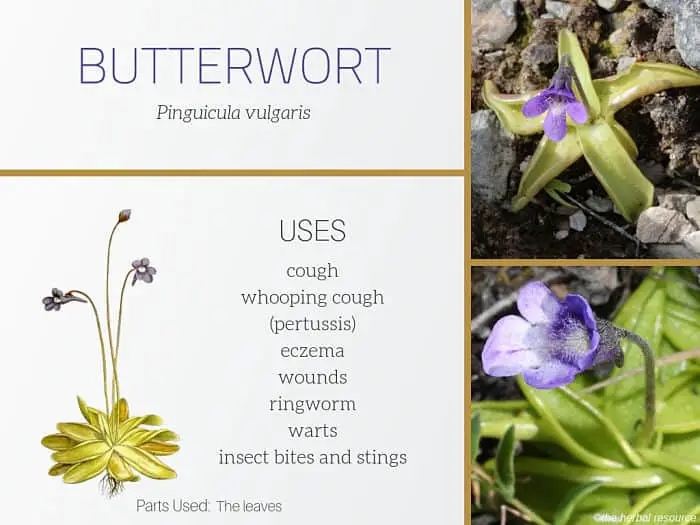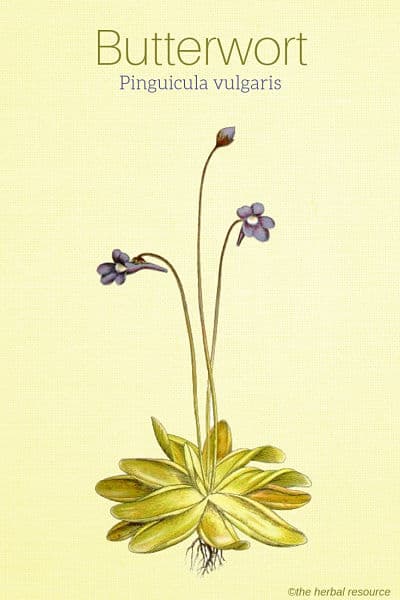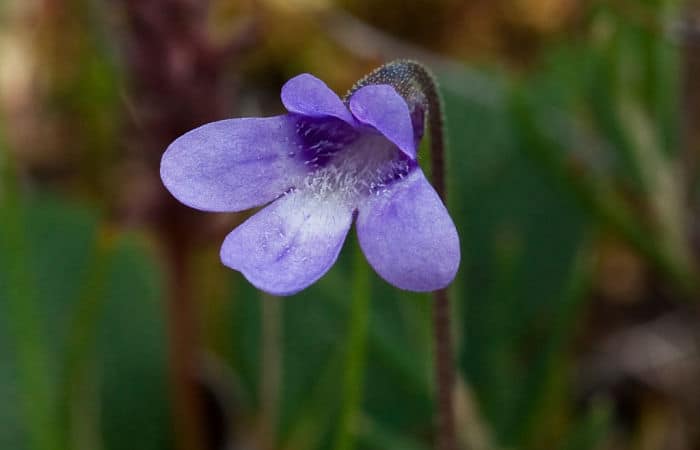Botanical Name of Butterwort: Pinguicula vulgaris.
Butterwort is an insectivorous/carnivorous plant that belongs to the bladderwort family (Lentibulariaceae.)
The genus name Pinguicula is derived from the Latin word “pinguis,” meaning fat referring to the thick, greasy appearance of the leaves.
The English common name butterwort probably comes from the plant’s ability to curdle milk, but it might also be because of its mucilage covered leaves.
Its alternative names bog violet and marsh violet is due to its bright purple flowers.
What is Butterwort Used For?
The therapeutic uses and benefits of butterbur are solely based on tradition and herbal folk medicinal applications.
No scientific studies have been done on the herb’s effectiveness.
People have used butterwort, e.g., for the following ailments and conditions:
- cough
- whooping cough (pertussis)
- eczema
- wounds
- ringworm
- warts
- insect bites and stings
Medicinal Properties of Butterwort
Butterwort is rarely used in contemporary herbal medicine.
It is regarded to have antispasmodic, antitussive and wound-healing properties.
The leaves can be used as a cough suppressant, and herbal tea made from the butterwort leaves has been used as a relief for a chronic cough, whooping cough, and other respiratory diseases.
These uses correspond to those of common sundew (Drosera rotundifolia), which is also a carnivorous plant with a lot of mucilage on the leaves.
A homeopathic remedy is made from butterwort and used for the treatment of whooping cough and minor throat irritations.
Uses in Folk Medicine
Butterwort was once widely used in folk medicine, but much of the knowledge regarding the herb’s uses as an herbal medicine has probably been forgotten.
Still, it is known that the leaves, used externally as a poultice, were applied to wounds to speed up the healing process and to get rid of warts. Furthermore, the herb was used as a remedy for skin rashes, eczema, and ringworm.
Also, the herb was touted to be effective for insect bites and stings by rubbing the mucilage from the leaves directly on the affected area.
In Wales, England, it was commonly used in the past as a purgative.
The herb has also been used for dying hair, yielding a yellow color and a decoction from it was used as an herbal shampoo.
An ointment, made from the boiled butterwort leaves and cream or other fatty substance, was used on sore udders of cows.
An Insectivorous Plant
Butterwort is an insectivorous or semi-carnivorous plant because it can grow well without trapping insects. Still, it needs to become carnivorous to reproduce.
The upper surface of the basal rosette’s leaves is coated with a mucilage containing numerous enzymes.
The mucilage-producing glands consist of 8-32 cells that form a spherical gland organ which is located at the end of a stem, which is again attached to the leaf surface.
On the upper side of the leaves there is also small enzyme producing glands that lack stalk and consist of only 2-8 cells, but in return, they are far more numerous than the mucilage forming glands.
When an insect is trapped the plant folds its leaves to engulf the insect, a reaction triggered by the struggle of the insect and chemical recognition.
Together the mucilage and the enzymes form a liquid layer around the small insect.
The liquid also has a soap-like effect so it can come in direct contact with the surface of the insects, which is initially water repellent.
The enzymes in the fluid then break down or digest the various insect parts, and the degradation products are gradually picked up by the enzyme-producing cells, which can separate and absorb organic substances.
In two days or so, the only thing that is left of the insect is the indigestible chitin skin and the wings.
In this way, butterwort can utilize nitrogen and another energy-rich compound of the insects, and can, therefore, grow in places where the soil is very poor and few other plants can. 1
Butterwort Uses to Curdle Milk
The plant was once used to curdle milk and still is, mostly in Scandinavia.
When the leaves are added to milk, they release protein-splitting enzymes that make it curdle. This ability has been validated by scientific methods. 2
The fresh leaves are placed in a strainer, and the milk is poured over them. After a day or two, the milk sours and becomes solid like yogurt.
A small quantity of the milk can be kept to inoculate further batches.
In Scandinavia, the leaves are used to produce dairy products which are available commercially under the Swedish names “filmjölk” and “tätmjölk” and are regarded to be quite delicious.
Active Substances and Constituents
Butterwort contains mucilage, tannins, benzoic acid, cinnamic acid, and valeric acid.
Cinnamic acid has anticonvulsant properties.
The fresh leaves have small glands with a number of digestive enzymes (such as protease, esterase, and phosphatase).
Plant Parts Used
The leaves of butterwort are used in herbal medicine.
They are harvested in mid-summer and are used either fresh or dried. In folk medicine, it was mostly the mucilage on the leaves that was used.
Therapeutic Dosage and Administration
No established dosage guidelines have been set for using butterwort for therapeutic purposes.
When or if the herb is intended for medicinal use, a trained and licensed herbalist should be consulted before using it.
Side Effects and Interactions of Butterwort
As of yet, no information regarding the possible side effects or contraindications of butterwort seems to be available.
Other Common Names
- Common butterwort
- March violet
- Bog violet
- Yorkshire sanicle
- Earning-grass
- Hleypisgras (Icelandic)
- Tettegras (Norwegian)
- Vibefedt (Danish)
- Gewöhnliches Fettblatt (German)
- Grasilla (Spanish)
- Siniyökönlehti (Finnish)
- Grassette vulgaire (French)
- Tätört (Swedish)
Habitat
Butterwort has a circumboreal distribution. It is native to most European countries, including Russia as well as Canada, and the United States.
The plant thrives in damp areas such as bogs and swamps and low or subalpine elevations.
Description
Butterwort is a perennial plant that can grow up to 10 cm in height. It has a small taproot and glabrous, usually single stem.
The yellowish elliptic and succulent greasy leaves that are rolled in the edges form a basal rosette. The leaves have glandular-viscid on the upper surface to trap small insects.
The flowers are purple violet and fruit is an ovoid capsule. The flowering stem becomes erect as the seeds inside mature.
Supporting References
Forlaget Det Beste: Våre medisinske planter. Oslo, Det Beste A/S 1984.
Botanical Society of America, Pinguicula – the Butterworts.
Jonsson, Sune & Stina Jonsson: Villblomster. Markens urter i bilder og tekst. Oslo, Teknologisk Forlag 1980.
Keddy, P.A. (2010). Wetland Ecology: Principles and Conservation (2nd edition). Cambridge University Press, Cambridge, UK.
Penskar, M.R. and J.A. Hansen. 2009. Special Plant Abstract for Pinguicula vulgaris (butterwort). Michigan Natural Features Inventory, Lansing, MI.4 pp.
Leknes, Ingvar Leiv: Tettegras – insektfangande plante. Blyttia 60 (2002) s. 126.
Thordur Sturluson
Latest posts by Thordur Sturluson (see all)
- What is the Difference Between Hemp and Marijuana? - June 3, 2019



I receive regular emails from you, but nowhere on your website can I find a very important warning. This should be to warn people not to pick wild plants because (in the UK) it is often illegal and many plants have been virtually wiped out by overpicking. It is very irresponsible of you to encourage this.
The information you mention is readily available on The Herbal Resource. https://www.herbal-supplement-resource.com/ethical-foraging/
And it always comes down to where you are harvesting and which plants. Harvesting dandelions, for example, is not the same as harvesting endangered species such as Arnica Montana or Goldenseal, plants that should only be cultivated and not picked from the wild.